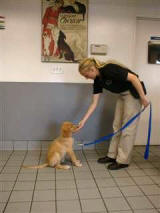The preferred method for
teaching dogs to respond to
verbal cues or hand signals is
to first
SHOW the dog exactly
what the word means by using
food to lure the dog into the
desired
 position.
position.
Typically, you
start with a dog treat in your
right hand placed in front of
the dog's nose. By moving the
treat (often while the dog is
licking it) you move the dog's
head to move the body into
position.
When the dog is
in the
desired position, you release the treat.
After you lure the dog
into position with food
in your hand, try luring
without the food in the
hand. (Dogs learn body
language very quickly.)
Use the other hand (not
the lure hand) to
deliver the treat. Over
time, your dog will
learn how to earn
treats, and other
life
rewards.
If the "luring" method is not
working to
teach your dog what positions or
behaviors gain the reward, there are second, third
and fourth preferred lessons you
can try.
Think of training as a puzzle
your dog gets to figure out.
Imagine your dog trying
different things to gain the
reward of choice. Some dogs are
motivated to figure out these
puzzles to get food, others to
get toys or play time. Anything
your dog enjoys makes a great
motivator for learning.
Reinforce learning by calling
your dog before going on a walk.
Require your dog to sit for a
meal. Have your attention be the
reward for your dog settling on
a mat.
Begin lessons
(learning games) before
meals when the dog is hungry.
Use a happy voice tone and
be sure you
relax all your muscle tension.
Your dog reads your body better
than you do! With
a happy but not forced face, set
the tone. "This
is going to be fun!" Then, give
one treat for free.
|
It is best to teach the dog
to "sit" before teaching the
dog to "lie down" or "stay."
You can teach "heel " at any
time. |
 The
"sit" instruction means, "Place your
rump on the ground."
The
"sit" instruction means, "Place your
rump on the ground."
The "down" instruction means, "Lie
down, belly on the ground on all four
feet."
The
"stay" instruction means, "Freeze
in this exact position until
released."
The "heel" instruction means, Walk
directly at my left side, at the
pace I set.
The "come"
instruction means race to me so
you don't miss a favorite reward
(not given every time. Give the
best rewards for the best
responses. ALWAYS praise your
dog in a loving voice for coming
to you and looking at you. Make
it worth your dog's while and do
not give your dog any reason to
hesitate.)